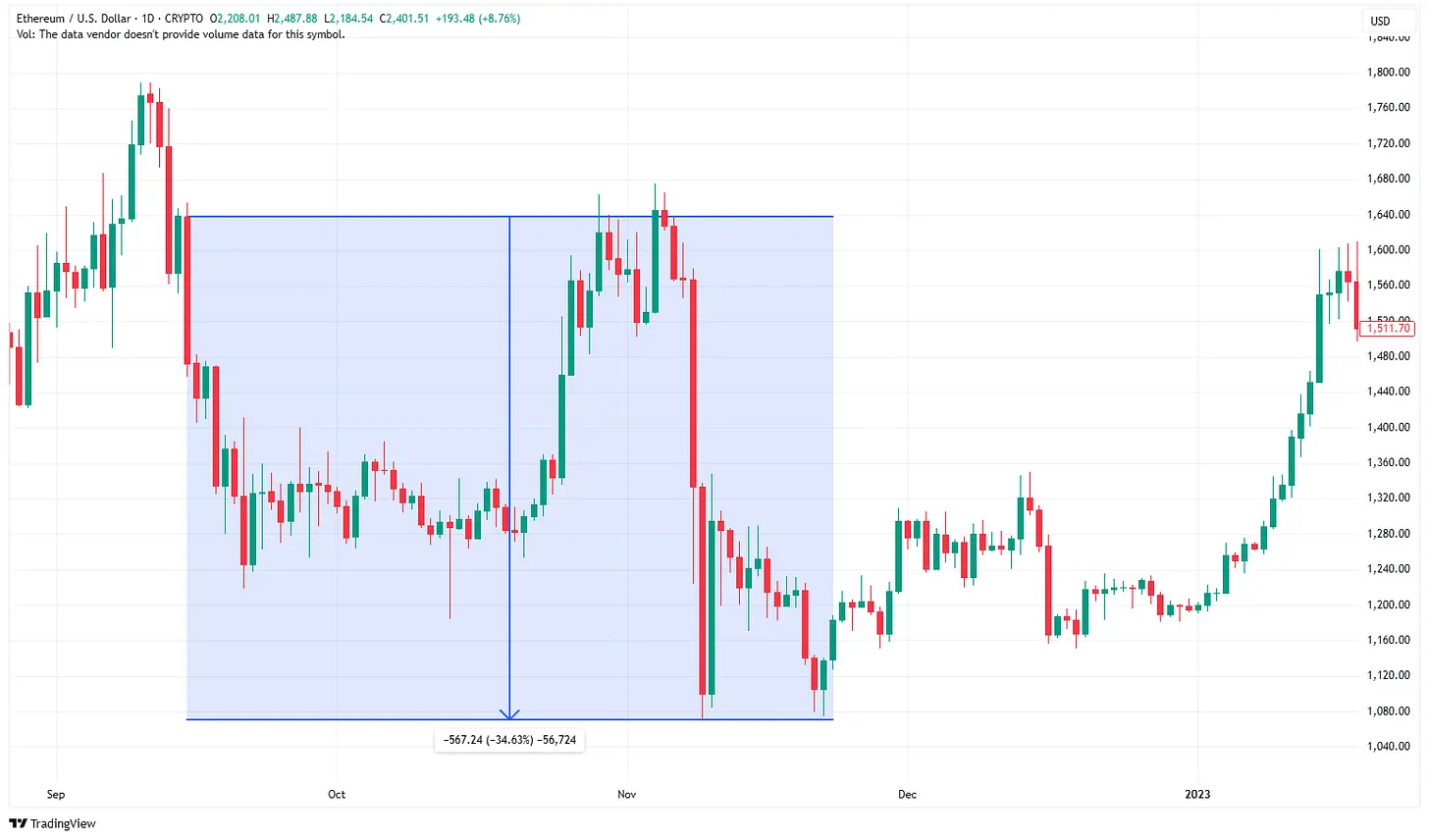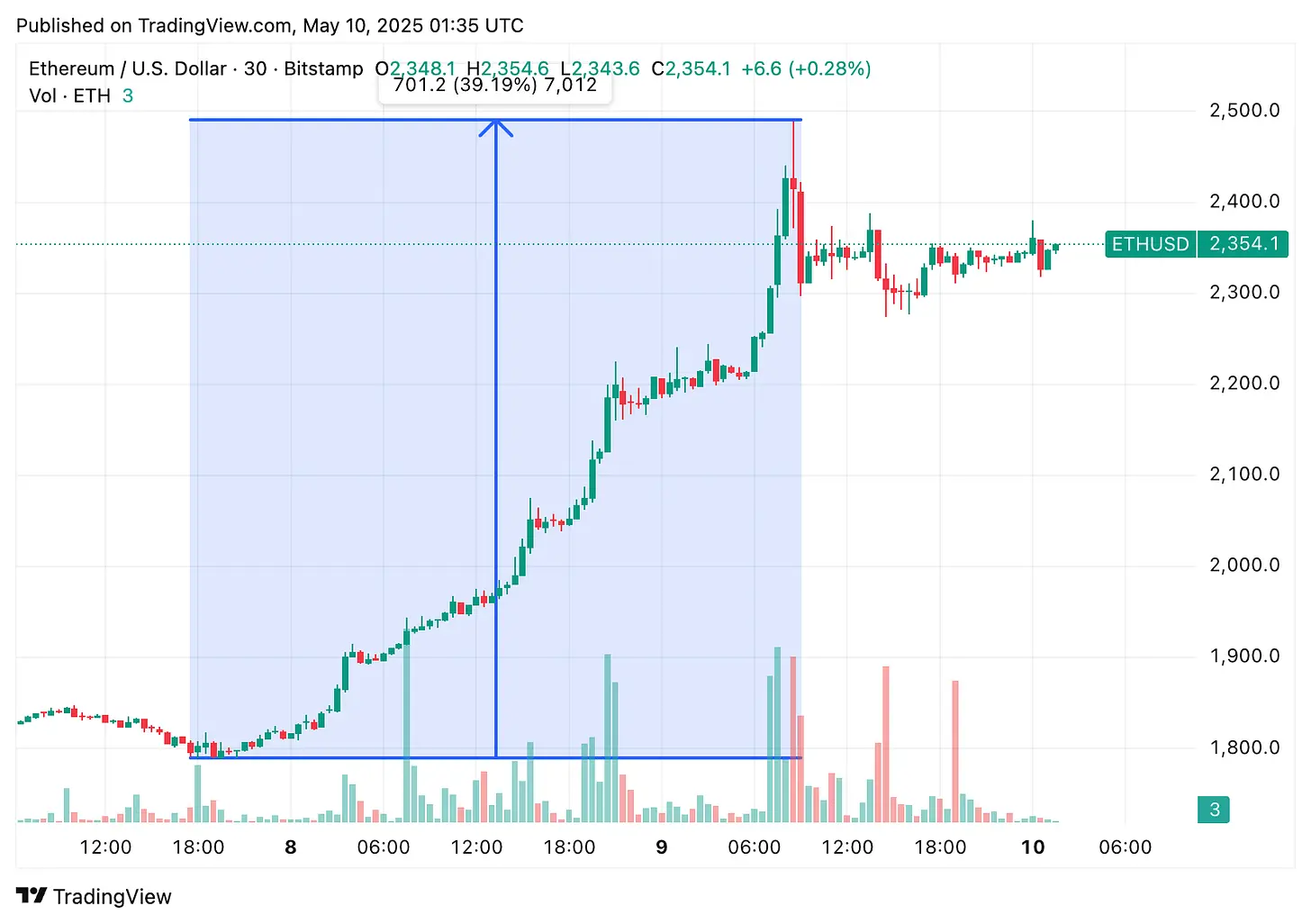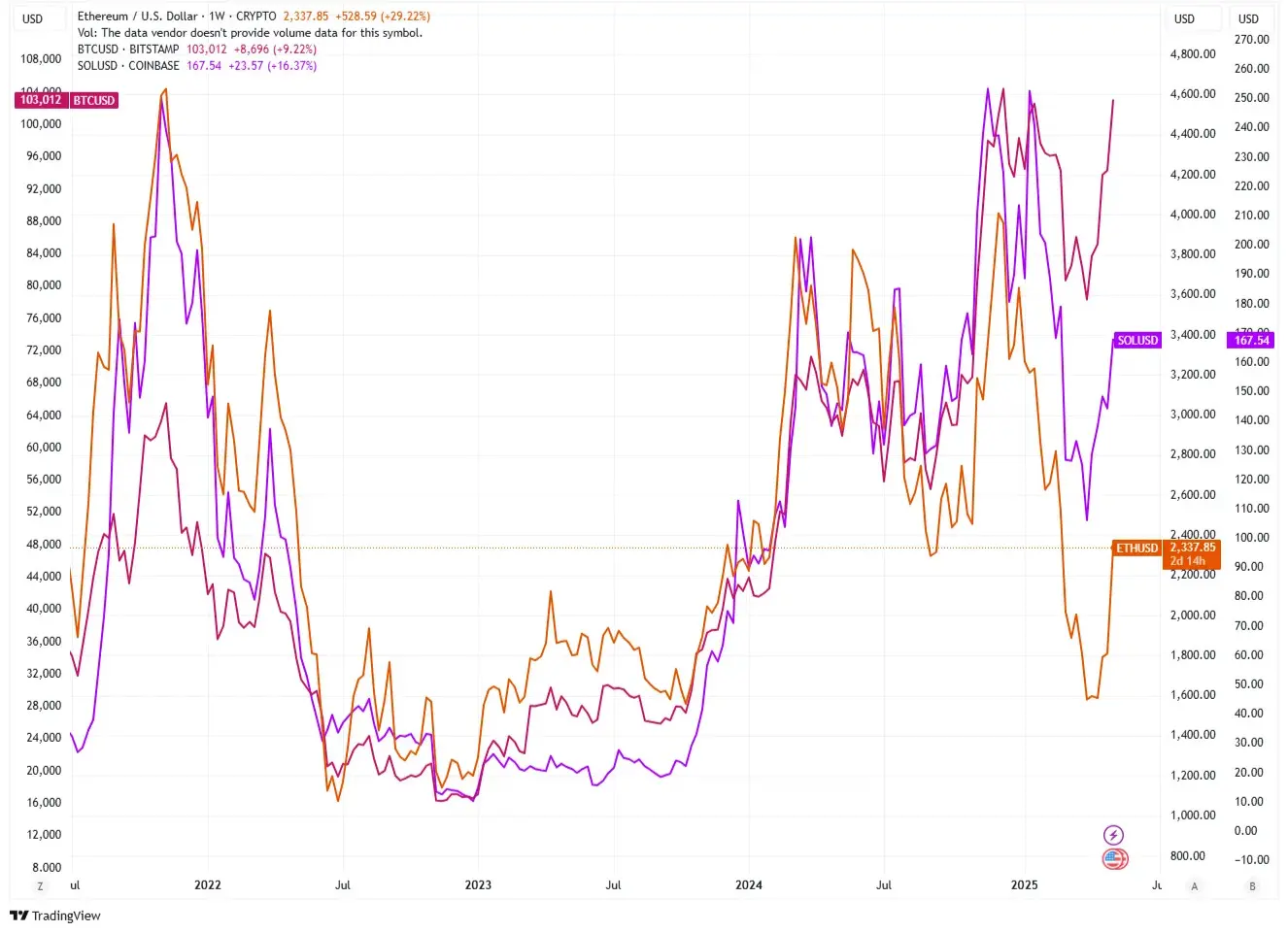Last Wednesday, after the Pectra upgrade, ETH recorded its strongest weekly performance since 2021.
Original Title: "Can Pectra, UX and Team Shuffle Revive ETH?"
Compiled by: Patti, ChainCatcher
"One of Bitcoin's most outstanding qualities is that its protocol is designed so elegantly and simply." This was said by Vitalik Buterin, the founder of the second-largest cryptocurrency Ethereum, when discussing the largest cryptocurrency, Bitcoin.
The timing of this statement coincides with the identity crisis that Ethereum is currently facing.
A week ago, Vitalik wrote this in his blog post "Simplifying the L1." Three days later, Ethereum developers deployed the most complex upgrade to the network to date onto the blockchain.
On one hand, after the Pectra upgrade on Wednesday, ETH achieved its strongest weekly performance since 2021. On the other hand, its co-founders hope to rebuild the network with a simpler architecture.
Is this the beginning of Ethereum's revival, or is this yet another false dawn for a network that has stagnated for years while its competitors continue to reach new highs?
In this article, we will explore what changes are happening in Ethereum, why these changes are important, and whether these rapid developments can help Ethereum break free from years of stagnation.
Pectra Upgrade: A Key Battle in Ethereum's Revival Attempt
The success or failure of Ethereum's revival attempt largely depends on its recent upgrade.
On May 7, 2024, the Pectra upgrade— the largest code change since The Merge (September 2022)—was officially launched. This upgrade made wallets smarter, improved validator efficiency, and reduced Layer 2 fees.
The completion of this upgrade took more than a month longer than originally planned, fundamentally changing how Ethereum operates. Among the core content, Ethereum Improvement Proposal (EIP)-7702 granted smart contract functionality to regular wallets.
This seemingly technical change has actually reshaped the fundamental user experience.
An anonymous contributor to the Optimism project, Binji, wrote on the X platform: "Ethereum has finally started to feel like a modern network." He also added that the Pectra upgrade reduced the number of clicks users needed to "get things done."
In simple terms, this upgrade brought the following conveniences to users:
- Users can now bundle multiple operations together without having to approve each step of the transaction individually.
- Users can pay transaction fees with stablecoins instead of having to use Ethereum (ETH) for every transaction.
Dapps can even pay gas fees for users, enabling a "freemium" model where users do not need to hold any ETH to interact with them.
For validators, EIP-7251 significantly raised the staking limit from 32 ETH to 2048 ETH. This means lower operating costs, which is particularly beneficial for institutional stakers.
Layer 2 also benefits from this.
EIP-7691 doubled the blob space in each block, helping to keep Layer 2 transaction fees low in the face of increasing demand. This upgrade comes at a crucial time—Jesse Pollak, a developer at Coinbase's Base Chain, previously warned that demand for Layer 2 could grow "10 to 20 times" by 2025.
So, can these technical improvements translate into a rebound in market confidence?
Historically, Ethereum upgrades have often been accompanied by the situation of "good news being fully priced in." After the "Merge" upgrade in 2022, the price of ETH fell by more than 30%.

@TradingView
However, this time may be different, as the code changes are accompanied by shifts in narrative and leadership.
What was the result? Within 40 hours of the Pectra upgrade going live, the price of ETH surged by about 40%.

@TradingView
Vitalik Calls for a Redesign of the Ethereum User Experience
Three days before the official launch of the Pectra upgrade, Vitalik Buterin published perhaps his most important vision statement in years—"Simplifying the L1."
The core message he conveyed in the article is that Ethereum must become "close to as simple as Bitcoin" within five years.
For years, Ethereum has increased its complexity to address various technical challenges, and now, this co-founder hopes to remove that complexity to ensure the network's long-term viability and resilience.
In his vision statement, he pointed out that even high school students can understand Bitcoin's code. In contrast, Ethereum has become increasingly complex, limiting the range of people who can effectively contribute to it.
Vitalik's plan includes three radical proposals:
- Replace the Ethereum Virtual Machine (EVM) with a RISC-V architecture. The RISC-V architecture is simpler and more efficient, promising "a hundredfold performance improvement."
- Simplify Ethereum's consensus mechanism with "3-Slot-Finality," eliminating complex systems like epochs and validator shuffling.
- Standardize the entire technology stack's protocols from data encoding to tree structures.
Restructuring of the Ethereum Foundation Leadership
In February of this year, Aya Miyaguchi, the executive director of the Ethereum Foundation, announced her transition to the newly established position of "Chair," putting an end to months of community dissatisfaction with the foundation's leadership and direction.
Previously, critics increasingly questioned the foundation's approach—whether prioritizing ideological purity over competitive positioning in an increasingly competitive market environment could still meet Ethereum's development needs.
The resulting restructuring was finalized at the end of April, marking a significant governance change in the history of the Ethereum Foundation.

@Ethereum
The newly appointed leadership of the foundation quickly clarified their work priorities: expanding Ethereum's mainnet capacity, improving Layer 2 rollups, and enhancing user experience.
Two co-directors wrote in a public statement: "We are acutely aware of the need to accelerate the journey for developers, founders, institutions, and others to develop on Ethereum and adopt Ethereum technology."
For years, the foundation has maintained a "neutral" stance on ecosystem development, avoiding participation in any activities that seemed like marketing or competitive positioning.
The newly appointed co-director Stańczak stated in an interview with Bankless that improving communication is now a priority for the foundation, and "clearly conveying messages is also part of marketing."
This simple statement represents a dramatic shift compared to the foundation's previous reluctance to even acknowledge marketing as a legitimate function.
Challenges Still Exist
Despite these promising developments in Ethereum, it still faces significant resistance.
Currently, the trading price of Ethereum ETH is about $2200, less than half of its all-time high of $4878 set in November 2021. Meanwhile, Bitcoin and Solana have both surpassed their previous records in 2025, while Ethereum remains at a low level.

@TradingView
In March, affected by market turmoil caused by Trump's tariff policies, ETH's decline exceeded that of other mainstream cryptocurrencies, with prices briefly falling below $1600, marking the lowest level for the coin in a year and a half.
Critics point out that Ethereum's economic model has fundamental issues.
The Layer 2 paradox: Successful scaling of Layer 2 means reduced transaction volume on the mainnet, leading to lower fee income for ETH.
Inefficient staking: Before the Pectra upgrade, institutional stakers had to operate multiple validator nodes due to staking rules, increasing costs and reducing returns.
Accumulation of technical debt: The complexity of Ethereum has slowed the pace of innovation and raised the barriers to participation and contribution.
Additionally, competition is becoming increasingly fierce.
In February and April of this year, Solana's DEX trading volume surpassed that of Ethereum. Even in the institutional investment space, Bitcoin ETFs have captured the majority of investment inflows, while Ethereum-related products have seen relatively lukewarm market acceptance.
The leadership crisis in March further exacerbated these issues.
In this context, it is not difficult to understand why the Ethereum Foundation, Vitalik, and core developers are now actively taking action from multiple fronts. After all, maintaining the status quo is no longer sustainable.
So, can these changes reverse the challenges that Ethereum has accumulated over the years?
Ethereum's Transformation Calibration
The current transformation of Ethereum is not limited to individual upgrade measures but is a recalibration of its overall development path.
As this series of changes progresses, Ethereum has finally realized that outstanding technical capabilities alone are not enough to sustain a long-term presence in the cryptocurrency world.
The key lies in the timing of the changes. These changes come after Ethereum has experienced years of market share loss and poor price performance. After the Pectra upgrade, the price of ETH surged by 40%, indicating that investors still have a strong interest in Ethereum. However, Ethereum faces a tough competition against projects that have integrated simplicity into their design from the start rather than retrofitting it later.
The Ethereum Foundation's decision to bring technical experts into management positions and acknowledge the importance of marketing indicates that it has begun to address the cultural inertia that hinders its competitiveness.
The improvements achieved in the validator economic model and L2 scaling from the Pectra upgrade will bring positive benefits in the short term. In the long run, whether Vitalik's five-year RISC-V architecture vision can maintain its focus will be a significant challenge for Ethereum. After all, in its past development, Ethereum has often struggled to maintain focus due to conflicting priority tasks.
The upcoming next upgrade—Fusaka—will be a key indicator of Ethereum's strategic transformation. If this upgrade prioritizes mainnet improvements over Layer 2 network infrastructure, it will confirm that Ethereum's strategic shift is real and lasting, rather than a temporary measure.
The next 12 months will reveal whether these changes are truly a revival for Ethereum or merely a slow adaptation to market realities. For investors, whether the Ethereum network can steadfastly pursue its new direction will be reflected in the ongoing effectiveness of its leadership and the momentum of its development process, which is far more important than any single technical milestone.
If Ethereum can complete this transformation while adhering to its core values, its vision of a "world ledger" may reposition ETH as a cornerstone asset of the next-generation global financial system, with a value far exceeding the current price of $2200.
免责声明:本文章仅代表作者个人观点,不代表本平台的立场和观点。本文章仅供信息分享,不构成对任何人的任何投资建议。用户与作者之间的任何争议,与本平台无关。如网页中刊载的文章或图片涉及侵权,请提供相关的权利证明和身份证明发送邮件到support@aicoin.com,本平台相关工作人员将会进行核查。




